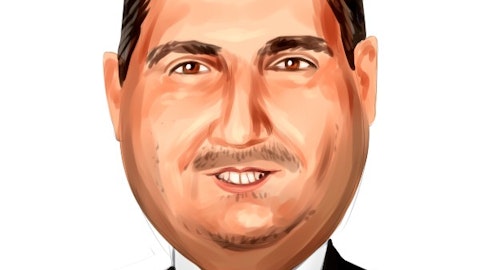Insperity, Inc. (NYSE:NSP) Q4 2022 Earnings Call Transcript February 9, 2023
Operator: Good morning. My name is Matthew, and I’ll be your conference operator today. I would like to welcome everyone to the Insperity Fourth Quarter 2022 Earnings Conference Call. At this time, all participants have been placed on a listen-only mode and we will open the floor for your question and comments after the presentation. At this time, I’d like to introduce today’s speakers. Joining us today are Paul Sarvadi, Chairman of the Board and Chief Executive Officer; and Douglas Sharp, Executive Vice President of Finance, Chief Financial Officer and Treasurer. At this time, I’d like to turn the call over to Douglas Sharp. Mr. Sharp, please go ahead.
Douglas Sharp: Thank you. We appreciate you joining us. Let me begin by outlining our plan for this morning’s call. First, I’m going to discuss the details of our fourth quarter and full year 2022 financial results. Paul will then recap the year and discuss our initiatives and outlook for 2023. I will return to provide our financial guidance. We will then end the call with a question-and-answer session. Now before we begin, I would like to remind you that Mr. Sarvadi or I may make forward-looking statements during today’s call, which are subject to risks, uncertainties and assumptions. In addition, some of our discussion may include non-GAAP financial measures. For a more detailed discussion of the risks and uncertainties that could cause actual results to differ materially from any forward-looking statements and reconciliations of non-GAAP financial measures, please see the company’s public filings, including the Form 8-K filed today, which are available on our website.
Now let’s discuss our fourth quarter results in which we achieved $1.21 in adjusted EPS and $79 million of adjusted EBITDA, significantly above both our expectations in Q4 of 2021, a quarter which was negatively impacted by higher COVID costs. Paid worksite employee growth of 14.3% in Q4, which is slightly below the low end of our forecasted range as we experienced a greater than expected slowdown in hiring by our client base. As for the other two growth drivers, worksite employees paid from new client sales and client retention came in near our Q4 forecasted levels. In a few minutes, Paul and I will comment further on the outcome of our recent fall sales campaign and heavy client renewal period, leading to our 2023 outlook. Fourth quarter gross profit increased 41% on the 14% growth in paid worksite employees and a 24% improvement in gross profit per worksite employee.
This improvement was largely driven by lower benefit costs as COVID-related costs continue to decline without a notable increase in health care utilization from previously deferred care. Other areas of gross profit, including pricing and contributions from our payroll tax and workers’ compensation areas, also improved over Q4 of 2021. Operating expenses increased 22% over Q4 of the prior year, which was slightly above our forecast and included continued investment in our service personnel given our high worksite employee growth, a planned increase in Business Performance Advisors, higher sales commissions tied to programs surrounding our Q4 sales volume and pricing, increased costs related to recruiting, travel and training, and costs related to our ongoing implementation of salesforce.
Net interest income improved over the prior year on higher interest rates and our Q4 effective income tax rate remained at 25%. Now let me recap our full year 2022 results. We achieved a 38% increase in adjusted EBITDA to $352 million and a 42% increase in adjusted EPS to $5.59, significantly above both our initial budgets and our recent guidance. These higher than expected earnings were driven by the significant growth in the paid worksite employees, execution of our long-term pricing strategy, and effective management of our direct cost programs, while making the key investments tied to our long-term growth plans. Our full year worksite employee growth of 18% over 2021 included an increase in worksite employees paid from new sales driven by an improvement in the sales efficiency of our Business Performance Advisors.
Client retention also improved from 82% in the prior year to 85% in 2022. And the third driver to our growth included robust hiring by our clients during the first half of the year, prior to the recent slowdown that I mentioned earlier. Gross profit per worksite employee per month or key pricing and direct cost metrics improved from $273 in 2021 to $286 in 2022. These results by increased utilization from previously deferred care. Effective safety and claims management, combined with the recent hybrid work environment, resulted in lower workers’ compensation costs. Operating expenses increased 18% over 2021, consistent with our worksite employee growth as we made key investments in our long-term growth plan. In addition to an increase in our service capacity, given the recent high levels of worksite employee growth, we made targeted adjustments to compensation levels of our corporate staff, given the current labor market dynamics and the inflationary environment.
Our 2022 compensation costs also included higher sales commissions and incentive compensation tied to our outperformance. We continue to invest in our technology, including the ongoing implementation of salesforce. And lastly, we experienced an increase in travel and event costs on higher prices and higher volume when compared to the unusually low levels during the pandemic in 2021. Now we continue to produce strong cash flow and ended the year with a solid balance sheet, while investing in the business and providing strong return to our shareholders. We invested $30 million in capital expenditures in 2022 and returned $150 million to stockholders through our dividend and share repurchase programs. We repurchased a total of 770,000 shares at a cost of $73 million.
We also paid out $77 million in cash dividends, which includes a 16% increase in our regular dividend rate in May of ’22. We ended the year with $224 million of adjusted cash, up from $163 million at the end of 2021 and continued to have $280 million available under our credit facility. Now at this time, I’d like to turn the call over to Paul.
Paul Sarvadi: Thank you, Doug, and thank you all for joining our call. Today, I’d like to start with comments on our excellent fourth quarter results and the dynamic we’ve seen in the marketplace as we entered the new year. Second, I’ll discuss our record setting full year 2022 results in the context of our internal five-year plan and the key initiatives that are continuing our momentum. I’ll follow this discussion with the key drivers of our outlook for continued success in 2023 and how this keeps us on track with our long-term goals. Our fourth quarter results capped off an excellent year in both growth and profitability. In addition, we executed a strong selling and retention campaign to continue growth into 2023 despite a slowdown in client hiring.
New booked workforce optimization sales came in at 96% of our aggressive fall campaign forecast. The highlight was continued success in our mid-market book sales, up substantially over the prior year and exceeding the budget. Another highlight was continued sales success in our traditional employment Workforce Acceleration book sales, which came in well over budget and well ahead of the same period last year. Q4 is also our heavy renewal period, with over 40% of our client base renewing around the year end. These renewals flow into the starting point for paid worksite employees in January and this starting point is foundational for our unit growth expectations for the coming year in our recurring revenue business model. Our Q4 renewal results were strong and our expected attrition flowing into January and February is expected to be slightly better than the average of the last several years.
Now this level was not as good as last year, but still solid results from a historical perspective. Another highlight of this heavy renewal period was continuing our strong pricing of our direct cost allocations and markup on our services. We were successful in achieving the targets, which we had set, to account for the higher inflation rates we are all seeing in the marketplace. So these key revenue drivers that we control, new sales, retention and pricing were very solid in the fourth quarter and rolling into the new year. Now one driver we have less control over is the net change in employment within our client base and this factor slowed more significantly than expected in Q4. To put this in perspective, this client growth factor was stronger than typical years in 2021 and the first half of 2022, as the post-pandemic economic rebound occurred.
The third quarter of last year slowed to a more normal rate and we forecasted for this slowdown in Q4 accordingly. Now keep in mind, we enroll every new hire and process every termination. So our net client growth numbers are actual real-time net hiring results, not an estimate. In the fourth quarter, net hiring in the base was only a slight increase, which was considerably below the third quarter. This contrasted with the relatively positive hiring outlook reported in the client survey we conducted late in the third quarter. Now this dynamic has continued through January. We have conducted an additional client survey to assess the sentiment of our client base to help plan this year. Historically, we compare actual data from client hiring and compensation, and we check for alignment with the outlook of business leaders.
Most of the time, these are in sync, but not always as in Q4. Now the good news is, our client sentiment was even more positive in the survey we conducted over the last couple of weeks as clients look ahead. More than half of the clients responding to the survey expect to increase staffing levels and more than 70% of those surveyed expect 2023 to be somewhat or significantly better than 2022. The top three HR concerns among survey respondents were building a strong culture, attracting talent and managing healthcare costs. Now these issues align with the key strengths of our service offering and reflect positively on the strong demand for our services. Now in a few minutes, I’ll explain how we’ve integrated the recent slowdown in hiring and the positive survey results into our outlook, but first, the full year record setting results reported today were an outstanding first year of our internal five year plan.

Photo by Israel Andrade on Unsplash
Our full year results were record setting in both growth, in the number of worksite employees and profitability in adjusted EBITDA. This demonstrated our balanced approach and highlights the strength of our business model. Now in addition to the significant financial outperformance of our plan, several key accomplishments in 2022 are driving our confidence going forward. Our five year plan is driven by 10 key success factors and significant progress is happening across the board. One of these success factors is improvement in sales efficiency, which we believe could add significant operating leverage to our financial model in the future. This year, we increased sales efficiency by 9% and incorporated changes designed to further this improvement.
We aligned commission incentives at all levels in the organization in order to focus on achieving quarterly goals and moving BPAs up to performance tiers. This was successful in 2022, and we’ve made further revisions to optimize these incentives moving into 2023. These incentives also incorporated changes to drive another key success factor in our five year plan, ramping up our Workforce Acceleration sales. Our 40% increase in these sales in 2022 validate we are on track with this initiative. Workforce Acceleration has the potential to further improve our sales efficiency, lower BPA turnover, and enhance our customer for life strategy for long-term client retention. And we’re still early in the ramp-up of this service and the contribution is relatively small.
However, this business also adds to gross profit without related risks included in the co-employment workforce optimization model. Our successful sales effort in ’22 was also supported by a 13% increase in marketing assisted sales, which was a new high watermark for marketing influence sales for a year. These results were related to another of our key success factors, which is extending our brand awareness and affinity and capitalizing on the increased demand for our services we’ve seen coming out of the pandemic. Another highlight of the year was our internal hiring success in the face of a continuing tight labor market. This effort directly supports our highest priority success factor, which is continuing to attract and retain people with the heart and dedication of our current staff.
This effort helped us catch up on hiring across the company to meet our growth related service demand and bring on our targeted number of BPAs to drive future growth. This has allowed us to begin the year with over 700 BPAs, a 9% increase over last year, which is in line with our long-term plan. The last key success factor to mention today is pricing and direct cost management, considering we’ve been in a higher inflation environment. Our discipline and consistency in this area has paid off considerably and we believe we’re well positioned going forward. So before I pass the call back to Doug, I’d like to provide some color around the approach we’re taking in our plan for 2023 and how this fits in as year two of our five year plan. We’re coming off a strong year with momentum in the primary growth drivers we control, sales and client retention.
However, the recent slowdown in client hiring has modestly lowered the starting point of paid worksite employees, and that needs to be factored into this year’s plan. Our recent survey of our client base implies solid hiring ahead in 2023, yet there’s a level of economic uncertainty in the air that we believe justifies a level of prudence in forecasting this factor. Now this has produced a wider range for our unit growth rate projection than we typically begin with each year. Interestingly, this wider range for growth is somewhat offset by a narrower range for gross profit that we’ve had over the last few years due to our strong pricing performance and expected normalization of direct costs. We’re also continuing investments to achieve the objectives of our five year plan with the goal of exceeding the strong five year run we experienced from 2015 to 2019.
Our compound annual growth rate in paid worksite employees over that period was 12.5% and adjusted EBITDA was over 24%. Also, one of the charts in the earnings presentation we released today shows the compound annual growth rate over the most recent five years in paid worksite employees and adjusted EBITDA of 10% and 15%, respectively. This is a significant improvement, since it includes a negative growth year in 2020 due to the pandemic related shutdowns. So when we add our 2023 expected performance to our recent record setting year, we’re still well ahead of our internal five year plan in growth and profitability, and we believe we’re making the right investments to continue to achieve the goals of our plan. I believe this is very important for our shareholders to understand, because if we perform according to this plan, the return to shareholders could be similar or possibly even better than our previous five year run.
Our total return to shareholders over that period was a remarkable 434%. Quarterly dividends increased an average of 27% each year, and the share price increased more than five-fold. Now we are focused company wide on the 10 key success factors we believe will capitalize on the strong demand for our services in the marketplace, achieve the goals of our internal five year plan, and produce compound annual growth rates that drive exceptional return to shareholders. At this point, I’d like to pass the call back to Doug to provide our specific guidance.
Douglas Sharp: Thanks, Paul. As I’m sure you’re aware by now, our worksite employee growth in 2022 was very strong and was significantly above our typical long-term targets. We are now entering a year with some economic uncertainty and a recent slowdown in the level of hiring by our clients. Therefore, we are beginning the year forecasting 2023’s worksite employee growth in a wider range than normal, with the midpoint in the high-single digits rather than our typical target of double-digit growth. Our outperformance in 2022 was even stronger at the earnings line. While this will create challenges with the comparisons, our 2023 earnings outlook remains strong, particularly given the current macro environment. Now let me provide some details behind our 2023 guidance.
Beginning with the results of our recent sales campaign and heavy client renewal period, and the possibility of less hiring by our clients, we are forecasting 10% to 11% worksite employee growth for Q1 of 2023. Subsequent to Q1, our growth is projected to be driven by an anticipated increase in the number of Business Performance Advisors and their sales efficiency. We expect client retention to remain strong, although at a slightly lower level than last year. And when combined with the possibility of less hiring by our clients over the balance of the year, we have forecasted a range of 7.5% to 10.5% growth for the full year. As for gross profit, we expect a strong performance last year to continue in 2023, although we are taking what we believe is a conservative approach to budgeting compared to our 2022 performance.
We currently expect our direct cost programs to return to a more normalized environment in 2023 with less uncertainty in the benefits in payroll tax areas. In addition, we expect a benefit from growth based administrative cost reductions in our UnitedHealthcare contract in 2023. So we are more comfortable with a tighter range of expectations in this area than the past couple of years. Now as far as our operating costs, we remain focused on the long-term initiatives in our internal five year plan. Our 2023 operating costs include the impact of successfully hiring sales, service and support personnel in the second half of last year. We plan to continue to grow the number of BPAs, and we believe our restructured sales commission program will drive further improvements in sales efficiency over the long term.
We also intend to continue investment in our marketing and technology to meet our planned objectives. As for our interest income and expense, our 2023 budget assumes the current interest rates and a run rate consistent with Q4 of 2022. Recent rate increases have had a positive impact on our adjusted EBITDA, given the interest income we earn on our cash and investments, including the funds in our workers compensation program. This is a component of our business model that has been depressed over a considerable period during the extended low rate interest rate environment. We are estimating a tax rate of 25% for Q1 and 26.5% for the full year 2023. So let’s now talk about the full year earnings expectations, which have a couple of comparison issues.
We are forecasting 2023 adjusted EBITDA in a range of $353 million to $409 million, ranging from relatively flat to a 16% increase over 2022. We are forecasting full year adjusted EPS in the range of $5.24 to $6.30, ranging from a decrease of 6% to an increase of 13% compared to 2022. Now the disparity between the forecasted adjusted EBITDA and adjusted EPS year-over-year growth rates is primarily driven by increased interest, depreciation and amortization expense, which are excluded from adjusted EBITDA. As for Q1, we are forecasting adjusted EBITDA in a range of $143 million to $153 million, an increase of 21% to 29% over the prior year’s quarter. We are forecasting adjusted EPS in the range of $2.40 to $2.60. The Q1 forecasted year-over-year earnings growth rates are higher than the full year 2023 rates due to quarterly comparisons to the prior year.
Earnings in Q1 of the prior year were negatively impacted by higher benefit costs associated with COVID. These COVID-related costs declined over the balance of 2022, particularly in the latter half of the year. Secondly, interest income started out low in Q1 of 2022 and increased over the course of last year. As a result, comparisons are more favorable in the first half of the year and more challenging in the second half. Now at this time, I’d like to open up the call for questions.
See also 10 Largest Economies in Europe and 12 Countries that Produce the Most Orange Juice.
Q&A Session
Follow Insperity Inc. (NYSE:NSP)
Follow Insperity Inc. (NYSE:NSP)
Operator: Certainly, at this time, we will be conducting a question-and-answer session. Your first question is coming from Andrew Nicholas from William Blair. Your line is live.
Daniel Maxwell: Hi, guys. Good morning. This is Daniel Maxwell on for Andrew. Just to get started, wondering what is assumed in guidance in terms of gross profit per worksite employee per month and then any puts and takes relative to the $286 million number you did in the full year 2022?
Douglas Sharp: Yeah. I think as you’re aware, we don’t give that as a key metric in our guidance. We reported the $286 million last year. Obviously, that’s a high mark for us, really contemplated the pricing strategy, long-term pricing strategy that we put in place from the outset of the pandemic through where we are today, and we’ve slightly exceeded those targets through that particular time period. And as you expect, there were fluctuations in benefit costs during the pandemic, post-pandemic, but we’re exiting — we exited 2022 in very good shape relative to our pricing in our benefit cost trend. We also obviously experienced some benefit from the remote work environment in our workers’ comp and we managed the payroll taxes accordingly.
So all that said, $286 million, if you look at our history is a high watermark for gross profit per employee. We’re not going to go into a year. We go through our regular typical process of budgeting gross profit going into a year with the intent of managing to the upside in each of the direct cost program areas. So, you wouldn’t expect us to go into 2023 budgeting at that same level. Now on the — what we did mention in my prepared remarks was, we do expect to realize administrative cost savings in our UnitedHealthcare plan relative to the significant growth that we’ve experienced and that we’re continuing to forecast. So that would be some upside in that particular area versus in previous years. So it gives you a little bit of a flavor there.
So hopefully, that will help you some.
Daniel Maxwell: Yeah. That’s helpful. And then as a follow-up, is there anything unique to call out from a healthcare activity or claims perspective? And in 2023, are you assuming any pent-up demand flushing through or is 2023 kind of looking like a more normal year?
Douglas Sharp: No, I think we’re looking at ’23 as more of a normal year as it relates to benefit and benefit utilization. Obviously, we went through 2022 with declining COVID cost, but we didn’t see a notable increase in utilization from care that was previously deferred when the pandemic was at its height. All that has — seems to have settled down through the latter half of 2022. So we do think barring any significant new variants that we’re entering 2023 in a more normalized environment, both from a benefit perspective but also from the unemployment tax area where that was also — had a little bit of volatility in it relative to the pandemic and its impact on unemployment and on state unemployment tax rates.
Daniel Maxwell: Great. Thanks. And then maybe if I can just squeeze one more in on pricing. Are you seeing any noticeable change in the aggressiveness of competitors when it comes to price? And if so, is that something that’s had any impact on new business generation or competitive win rates to this point?



